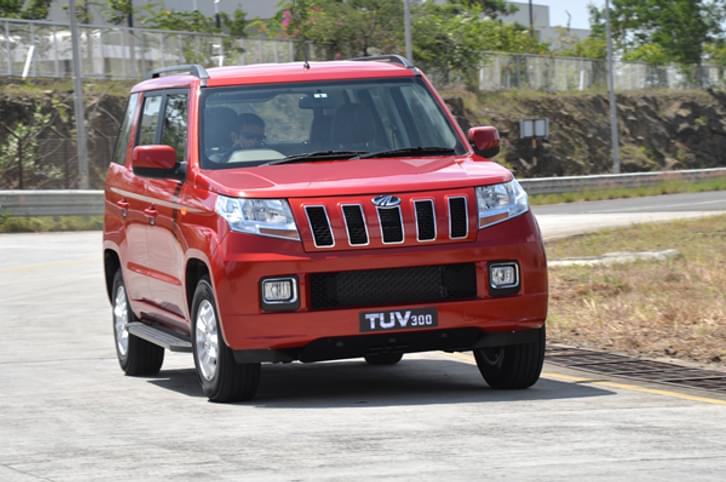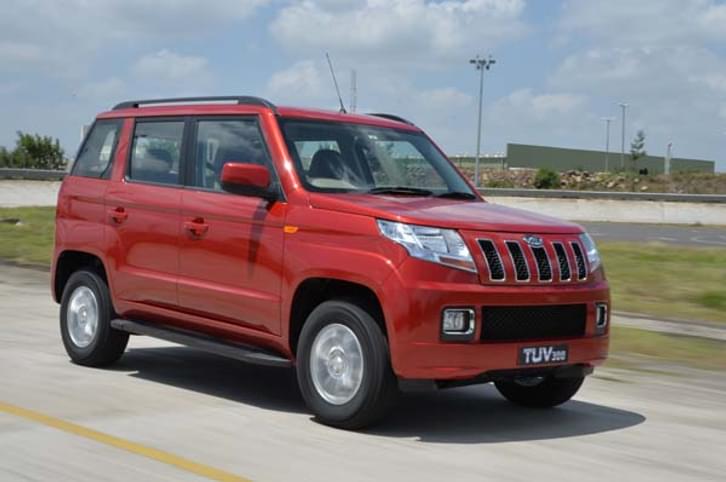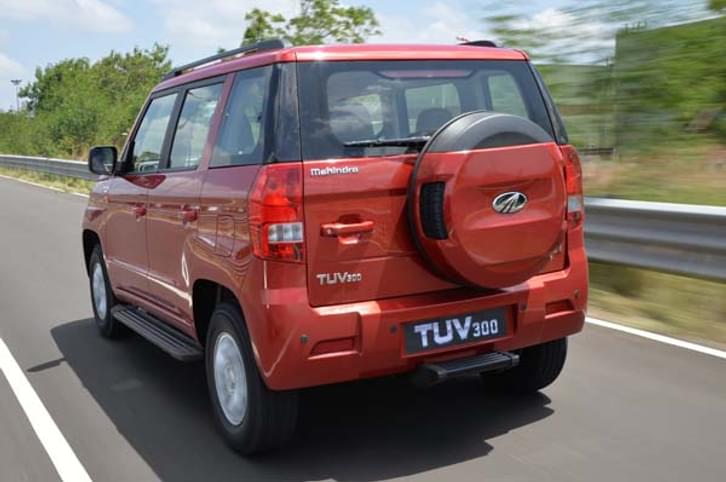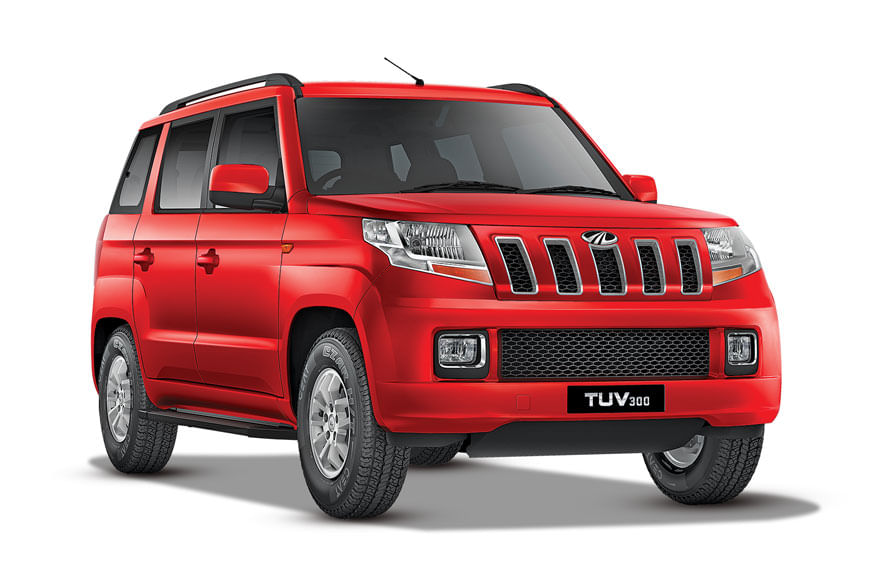Mahindra TUV300 review, test drive
A rugged, ladder-frame SUV with a new engine and a lot of space – all in a sub-four-metre footprint.
Updated on Sep 12, 2015 01:59:51 PM
94,680 Views
Follow us on



What is it?
Mahindra’s latest crack at making a compact SUV, and two things stand out in this statement. ‘Latest’ because, as you may remember, 2012’s Mahindra Quanto was also marketed as a compact SUV, with not a lot of success. And ‘SUV’ because, unlike the Quanto, the new Mahindra TUV300 is not derived from an MPV, nor is it a monocoque crossover like its main rival, the Ford EcoSport. It has been engineered from the grounds up to be a tough, ladder-frame SUV – albeit a compact one – and that’s its USP.
Okay, it does share its chassis architecture with the new Scorpio, and that means a hydroformed frame, independent double wishbone suspension at the front, and a non-independent, multi-link, coil-spring setup at the rear. Interestingly its 190mm ground clearance is 10mm more than the Scorpio’s, and the generous 2,680mm wheelbase is identical, but the commonality ends there; this is a clean-sheet SUV. Just for reference, however, though the clearance is more than the Scorpio’s, it’s 10mm less than the EcoSport’s. Similarly, though it’s lighter than the Scorpio, it’s still about 300kg heavier than the Ford!
| Mahindra TUV300 Price, Mileage, Specifications, Features and Variants | |
|---|---|
| Brand | Mahindra |
| Model Name | TUV300 |
| Mahindra TUV300 Price | NA |
| Mahindra TUV300 Range/Mileage | Diesel : 17.33 - 18.04kpl |
| Mahindra TUV300 Specifications | SUV | 5 doors | 7 seats View All Specs |
| Mahindra TUV300 Features | Halogen headlight | 7-inch Touchscreen display | 2 airbags View All Features |
| Mahindra TUV300 Variants | T4+ | T6+ | T8 View All Variants |
Let’s start with the look. The ‘T’ in TUV stands for ‘tough’ and this new SUV wears that attribute on its sleeve. The grille clearly draws more than a little inspiration from Jeep’s modern chrome rectangular look, and this theme is reflected in the fog lamps and huge air dam. The headlamps have a hint of Bolero in them, but do look quite smart in their own right. Because of the four-metre length restriction, a bluff front and bolt upright rear were somewhat inevitable. Mahindra has used a bit of visual trickery to disguise the boxiness, with varying degrees of success. The blacked-out D-pillars, raked-back B- and C-pillars and thick shoulder line, for example, do give it some character, but then the tall bumpers, huge square wheel arches, fat 75-profile tyres and dwarfed 15-inch wheels only emphasise how slab-sided and disproportionate the TUV300 is. The 1,839mm height on a 3,995mm long car seems too tall and ungainly, and a bit of black cladding around the base would have gone a long way to reduce the visual bulk.
All this, of course, was an intentional move by Mahindra’s designers to give the TUV300 that proper, chunky SUV look, and so there’s also the requisite placement of the spare wheel on the tailgate. Sadly, big bulk just doesn’t work as well on a sub-four-metre car.
What’s it like on the inside?
Now this is a different story altogether. Unlike the exterior design, which follows the similar boxy template of Mahindra’s other ladder-frame SUVs, the Scorpio and Bolero, great effort has gone into making the TUV300’s interior friendlier and more car-like. Engineers didn’t have to stick to a template, and could change a lot of interior bits to improve space, comfort and even the driving experience, unlike the new Scorpio, which had to stick to its decade-old body-in-white (and consequently, its interior layout) despite the new chassis. As a result, the TUV’s interior is actually better in some ways than the Scorpio’s. Despite the 10mm higher ground clearance, for instance, the seats are placed lower, which not only improves ingress and egress (most will not need the provided foot-step) but also lowers the vehicle’s centre of gravity. You still get a sufficiently commanding driving position though.
The dashboard design is a breath of fresh air for a Mahindra SUV – a wonderful mid-point between the Scorpio’s angular utilitarian shape and the XUV500’s over-styled excess. It has contours and rounded edges, a smart looking texture, and a good use of glossy black and matte silver plastic on the centre console, which ‘flows’ out towards the gear lever. The doors have soft, cushioned arm rests and grab handles that look quite classy. The door handles aren’t the same rough-cut pieces from the Scorpio, and many of the buttons are new too. The new steering wheel has a neat, unique design, and even the hooded instrument binnacle, with its chrome rings and digital info display, looks really, really smart. This mature new design is a huge step forward for the company.
However, some gaffes still remain. The window switches at the front are mounted near the handbrake, not on the doors, and the unit is basically lifted straight from a Scorpio’s driver-side door. Though they’re fewer and harder to spot than on other Mahindras, there are still plenty of rough edges on trim pieces around the cabin, especially lower down. The Scorpio’s problem of inaccessible door pockets has been addressed at the front, but you still have to open the door to reach the ones in the second row. There are several cubbyholes around the cabin, but many of them are too small and shallow to be used for anything other than change; at least there are bottle holders in each door and cup holders between the front seats.
An area where there has been no compromise is passenger space – there’s simply loads of it. The front seats are big and accommodating, though a little too high on thigh support, much like in the Scorpio. However, that issue doesn’t recur at the rear, where support is just right. Legroom, headroom and shoulder room back here is ample for three passengers, without issue. Now we never recommend side-facing jump seats, especially in sub-four-metre cars, but it has to be said that, for once, even adults could conceivably use them, over short distances at least. There’s just about enough width and height for most, and with a little bit of knee-interlock, two can easily fit back here. With the jump seats folded up, you get 400 litres of space, and fold the middle row down (it doesn’t split or flip forward though) and it will expand to 720.
A quick word on equipment, and though there won’t be a touchscreen like on the Scorpio, the top-spec TUV300 T8 gets a pretty comprehensive in-house-developed integrated audio system with a monotone four-inch screen. There’s no CD player, but there’s USB, aux and Bluetooth connectivity. Better news, however, is compatibility with Mahindra’s Blue Sense app that lets you, among many things, control the audio system remotely, and check the vehicle’s speed and fuel level. Best of all, however, while ABS and dual airbags are standard on the T8, they can be had as a paid option on two lower variants as well.
What’s it like to drive?
The engine is called mHawk80, and it’s a 1.5-litre, three-cylinder diesel that does bear some relation to both the Quanto’s 1.5-litre three-pot as well as the Scorpio’s 2.2-litre, four-cylinder unit. It’s pretty high tech too, using a dual-stage turbocharger and a dual-mass flywheel. So though its power output is just 82.85bhp (16bhp less than the Quanto’s), thanks to two-stage turbocharging, the TUV300 promises to have much better driveability and responsiveness.
And it does. There is an impressive lack of perceptible turbo lag, and it is smooth without much of a step in power delivery; thank that dual-mass flywheel. Mahindra says the motor’s max torque of 23.4kgm is made at 1,500rpm and sure enough, that’s where the surge begins. The best part is that it still feels punchy enough for if you need to make quick and sudden progress, and that’s helped by the somewhat short gearing on the five-speed manual gearbox; also related to the one in the Scorpio. It’s also a fair bit more refined than the Quanto, which itself was not too bad for a three-cylinder diesel, though you still get some vibration through the tall gearlever. This mHawk80 motor does, however, run out of breath quite early – around 3,800rpm – after which it’s all noise and no progress. And though the throw is quite short, the gearlever still feels too tall and utilitarian, and quite notchy too. Mahindra has also given the TUV300 its ‘micro-hybrid’ stop-start system, as well as two separate Eco modes – one for the powertrain and one for the AC, which dull performance for better economy. The result is an ARAI rating of 18.49kpl, which is just 0.16kpl better than normal mode, but Mahindra insists it works much better in the real world.
As you might be able to tell from the photos, we’re at Mahindra’s test track, and as a result, a proper ride and handling test will have to wait till we get the TUV300 out on real roads. What we can tell you, though, is that the suspension set-up feels much like the one on the new Scorpio, and even though it’s not identical, the two are similar. There’s definitely an inherent firmness that you can feel as the tall TUV rocks around if you cross a speed breaker at a slight angle instead of head on, or crashes if you hit a sharp bump too hard. And though the stability overall is quite good (thank that long wheelbase), you still get a little up-and-down movement over undulations. You’ll be thankful for the firmer set-up on the whole though, as a soft set-up like in the previous Scorpio would have led to loads of body movement. It’s a tall, body-on-frame SUV, so of course there’s loads of body roll, but you’ll be quite impressed with how eagerly the front end steers into corners. This is by no means a driver’s car, but it’s tidier than you expect something of its height to be.
Should I buy one?
Verito and e2o aside, when it comes to passenger vehicles, Mahindra is a maker of SUVs. Even the Xylo is butch enough to be counted as one. So it’s important for such a brand to fill every niche within the realm of SUVs, and as you’ll soon see, that is exactly the company’s plan. While the Scorpio and XUV500 are tackling the crop of bigger premium SUVs, the TUV300 wants specifically to wipe the smirk off the Ford EcoSport’s face, and as such, is the only other sub-four-metre SUV around, save for the slow-selling Premier Rio. And before you ask, the Quanto is being refreshed and repositioned to sell alongside the TUV. As much as we try to avoid sticking to a manufacturer’s marketing strapline, toughness is really what this car is all about. It gives you a sense of strength and hassle-free solidity that only a ladder-frame SUV can. Not to mention an all-encompassing driving position. It’s incredibly spacious too, and the engine is impressively refined and responsive, at least for urban use. This is also one of the best Mahindra interior designs yet, and shows how quickly the company is moving forward in this respect. Though we haven’t driven it yet, the TUV300 also has the option of an AMT gearbox, and 4x4 and petrol versions are a possibility in the future.
However, while we’re sure there will be plenty of takers for this tough, rugged look and feel at a relatively affordable price, it seems a bit of an oddity in this segment, where nimble dynamics, refinement and driving ease are also valued highly. In fact, it’s reflected in the slightly awkward proportions, which seem to be trying too hard. And finally, though Mahindra has made great strides in this area, fit and finish is still some way shy of global competition. So, while it’s not perfect, we will say the TUV300 is one of Mahindra’s best efforts yet, and if you think monocoque SUVs are not ‘real’ SUVs, or you want the Scorpio’s tough, rugged appeal in a smaller, more affordable package, this is the way to go.
GAVIN D’SOUZA
Copyright (c) Autocar India. All rights reserved.




Comments
Member Login
Personal Details
No comments yet. Be the first to comment.